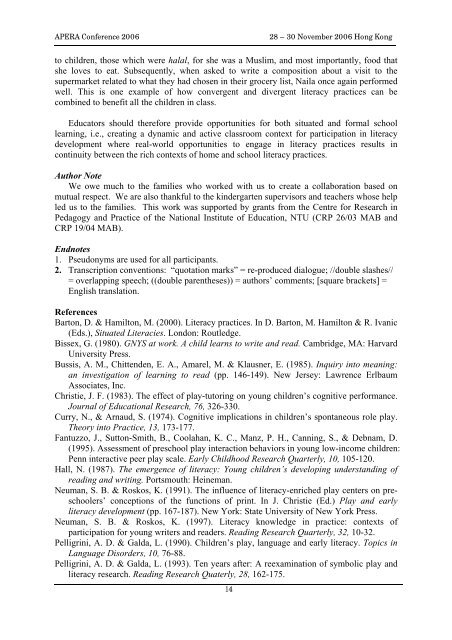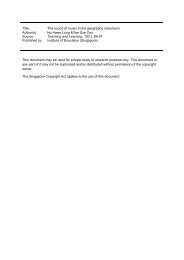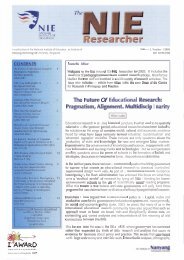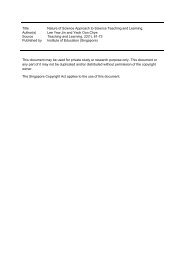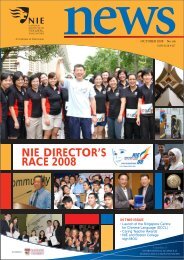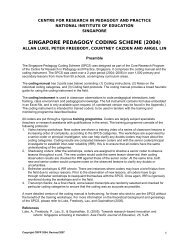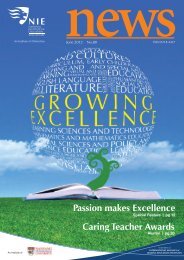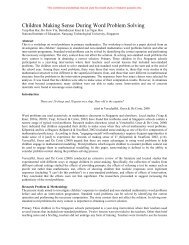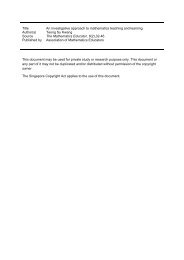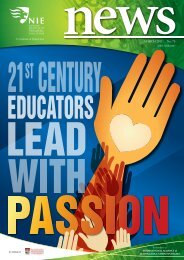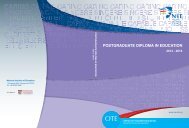The Influence of Symbolic Play on Early Literacy Development
The Influence of Symbolic Play on Early Literacy Development
The Influence of Symbolic Play on Early Literacy Development
Create successful ePaper yourself
Turn your PDF publications into a flip-book with our unique Google optimized e-Paper software.
APERA C<strong>on</strong>ference 200628 – 30 November 2006 H<strong>on</strong>g K<strong>on</strong>gto children, those which were halal, for she was a Muslim, and most importantly, food thatshe loves to eat. Subsequently, when asked to write a compositi<strong>on</strong> about a visit to thesupermarket related to what they had chosen in their grocery list, Naila <strong>on</strong>ce again performedwell. This is <strong>on</strong>e example <str<strong>on</strong>g>of</str<strong>on</strong>g> how c<strong>on</strong>vergent and divergent literacy practices can becombined to benefit all the children in class.Educators should therefore provide opportunities for both situated and formal schoollearning, i.e., creating a dynamic and active classroom c<strong>on</strong>text for participati<strong>on</strong> in literacydevelopment where real-world opportunities to engage in literacy practices results inc<strong>on</strong>tinuity between the rich c<strong>on</strong>texts <str<strong>on</strong>g>of</str<strong>on</strong>g> home and school literacy practices.Author NoteWe owe much to the families who worked with us to create a collaborati<strong>on</strong> based <strong>on</strong>mutual respect. We are also thankful to the kindergarten supervisors and teachers whose helpled us to the families. This work was supported by grants from the Centre for Research inPedagogy and Practice <str<strong>on</strong>g>of</str<strong>on</strong>g> the Nati<strong>on</strong>al Institute <str<strong>on</strong>g>of</str<strong>on</strong>g> Educati<strong>on</strong>, NTU (CRP 26/03 MAB andCRP 19/04 MAB).Endnotes1. Pseud<strong>on</strong>yms are used for all participants.2. Transcripti<strong>on</strong> c<strong>on</strong>venti<strong>on</strong>s: “quotati<strong>on</strong> marks” = re-produced dialogue; //double slashes//= overlapping speech; ((double parentheses)) = authors’ comments; [square brackets] =English translati<strong>on</strong>.ReferencesBart<strong>on</strong>, D. & Hamilt<strong>on</strong>, M. (2000). <strong>Literacy</strong> practices. In D. Bart<strong>on</strong>, M. Hamilt<strong>on</strong> & R. Ivanic(Eds.), Situated Literacies. L<strong>on</strong>d<strong>on</strong>: Routledge.Bissex, G. (1980). GNYS at work. A child learns to write and read. Cambridge, MA: HarvardUniversity Press.Bussis, A. M., Chittenden, E. A., Amarel, M. & Klausner, E. (1985). Inquiry into meaning:an investigati<strong>on</strong> <str<strong>on</strong>g>of</str<strong>on</strong>g> learning to read (pp. 146-149). New Jersey: Lawrence ErlbaumAssociates, Inc.Christie, J. F. (1983). <str<strong>on</strong>g>The</str<strong>on</strong>g> effect <str<strong>on</strong>g>of</str<strong>on</strong>g> play-tutoring <strong>on</strong> young children’s cognitive performance.Journal <str<strong>on</strong>g>of</str<strong>on</strong>g> Educati<strong>on</strong>al Research, 76, 326-330.Curry, N., & Arnaud, S. (1974). Cognitive implicati<strong>on</strong>s in children’s sp<strong>on</strong>taneous role play.<str<strong>on</strong>g>The</str<strong>on</strong>g>ory into Practice, 13, 173-177.Fantuzzo, J., Sutt<strong>on</strong>-Smith, B., Coolahan, K. C., Manz, P. H., Canning, S., & Debnam, D.(1995). Assessment <str<strong>on</strong>g>of</str<strong>on</strong>g> preschool play interacti<strong>on</strong> behaviors in young low-income children:Penn interactive peer play scale. <strong>Early</strong> Childhood Research Quarterly, 10, 105-120.Hall, N. (1987). <str<strong>on</strong>g>The</str<strong>on</strong>g> emergence <str<strong>on</strong>g>of</str<strong>on</strong>g> literacy: Young children’s developing understanding <str<strong>on</strong>g>of</str<strong>on</strong>g>reading and writing. Portsmouth: Heineman.Neuman, S. B. & Roskos, K. (1991). <str<strong>on</strong>g>The</str<strong>on</strong>g> influence <str<strong>on</strong>g>of</str<strong>on</strong>g> literacy-enriched play centers <strong>on</strong> preschoolers’c<strong>on</strong>cepti<strong>on</strong>s <str<strong>on</strong>g>of</str<strong>on</strong>g> the functi<strong>on</strong>s <str<strong>on</strong>g>of</str<strong>on</strong>g> print. In J. Christie (Ed.) <str<strong>on</strong>g>Play</str<strong>on</strong>g> and earlyliteracy development (pp. 167-187). New York: State University <str<strong>on</strong>g>of</str<strong>on</strong>g> New York Press.Neuman, S. B. & Roskos, K. (1997). <strong>Literacy</strong> knowledge in practice: c<strong>on</strong>texts <str<strong>on</strong>g>of</str<strong>on</strong>g>participati<strong>on</strong> for young writers and readers. Reading Research Quarterly, 32, 10-32.Pelligrini, A. D. & Galda, L. (1990). Children’s play, language and early literacy. Topics inLanguage Disorders, 10, 76-88.Pelligrini, A. D. & Galda, L. (1993). Ten years after: A reexaminati<strong>on</strong> <str<strong>on</strong>g>of</str<strong>on</strong>g> symbolic play andliteracy research. Reading Research Quaterly, 28, 162-175.14


